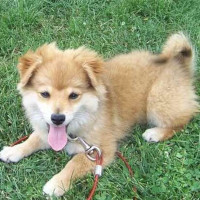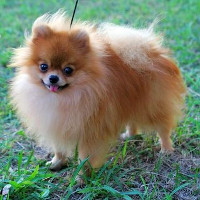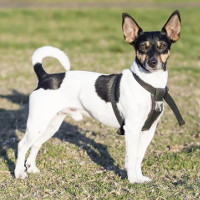Appearance of the Pomerat
|
| Pomerat dogs are small hybrid breeds and are a cross between a Rat Terrier and a German Toy Spitz / Pomeranian. They are small dogs weighing up to 7.5 kilos and measuring up to 30.5 centimeters. They can be black, black and tan or brown and white. Depending on the parent breed they take after most, they can be short-haired or long-haired. Your pet is likely to have a small, fox-like face with almond-shaped brown or hazel eyes with an alert expression. These are sturdy little dogs with erect ears that usually rest on the top of the head. The tail usually curves over the back. |
Temperament of the Pomerat
|
| The Pomerat is a small dog with a big personality. They are lively, friendly dogs who like to let off steam with family members. They are suitable for older children, but not recommended for the very young, as they can be injured quite easily and break if handled roughly. These dogs will enjoy playing with other dogs provided they are socialized from an early age. They are likely to be wary of strangers and bark, making them good watchdogs. They are energetic little dogs who thrive on the company of their owners, and are therefore suitable for people willing to invest time and energy in their pet. If left alone for too long, they can develop bad habits such as yard digging and barking. They are intelligent dogs that are easy to train, but need a confident owner who can make sure they know their limits. They are suitable for new dog owners. |
Needs and activities of the Pomerat
|
| For a small dog, the Pomerat is very energetic, especially if it takes after the Rat Terrier. Your pet will need daily walks and will be very playful, but will be more than happy to chase a ball around a yard and even play indoors with toys. They're prone to digging and trying to escape, so plenty of exercise is the best solution to this. Games and activities that stimulate them physically and mentally are best. They'll adapt easily to apartment life as long as they have company and get regular exercise. Your pet is relatively tough but won't do well in extreme conditions, so keep it warm in winter and don't exercise it when it's too hot in summer. |
Maintenance of the Pomerat
|
| The Pomerat doesn't shed excessively and is considered low-maintenance when it comes to grooming. Even if your pet has the longest German Toy Spitz / Pomeranian hair, it won't need more than a brush and comb twice a week to keep the skin healthy and avoid any matted effect. Shorthair varieties are even easier to groom with weekly brushing. These dogs don't need to be bathed regularly, and only with dog shampoo. To prevent dental problems, try to brush your dog's teeth every day and check the ears for dirt. Nails should also be trimmed from time to time. |









 English (United Kingdom)
English (United Kingdom)